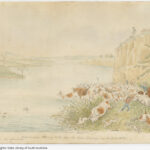The European occupation of South Australia demanded that land be farmed and stocked in line with ‘old world’ tradition. But it was expensive to import sheep, cattle and horses by sea, and many animals perished en route. One viable alternative was the droving of stock overland from New South Wales, the work of overlanders. Their motive was simple: high profit.
The first overlanders in South Australia
Charles Bonney and Joseph Hawdon, the first to overland stock, arrived in Adelaide on 4 April 1838 after a ten-week journey from a station on the Hume River, New South Wales. Their path along the River Murray brought them into contact with Aboriginal people, probably the first such contacts since Charles Sturt’s 1830 journey.
Edward John Eyre overlanded cattle three months after Hawdon and Bonney and also found the Aborigines generally numerous and friendly. But one month later, after safely droving a herd of cattle along the same route, Sturt predicted that violence would soon erupt. Eyre, who in March 1839 was the first to overland a large flock of sheep on the Murray route, advised that overlanders would need to be careful and diligent. Three weeks after Eyre’s journey, overlanders were attacked. Adelaide’s newspapers, full of reports on the topic, told only one side of the story.
Impact of the overlanders on Indigenous population
Other than Hawdon, Sturt and Eyre, few overlanders had any conception of Aboriginal culture, its formalities or obligations. As the size of flocks and herds increased they devastated the hinterland of the Murray. Hard-hoofed animals packed firm the soil, ate vegetation that was the basis of Aboriginal existence, consumed grasses that fed the native animals that supplied meat to the Aboriginal people, destroyed rushes and fibrous plants used for making nets, housing and baskets, and fouled the water. Overlanders, their stockmen and shepherds also raped Aboriginal women, spreading venereal disease throughout the Murray basin. Coupled with the aftermath of the smallpox epidemic of 1830, this decimated the Aboriginal population. By 1840 friction between overlanders and Aborigines had become open hostility. Government forces brought swift and violent ‘justice’ along the stock route. Aborigines replied, and violence became endemic.
The decline of the River Murray overland route
The River Murray route was seldom used after mid 1841. Profits had diminished and another, more expeditious path had been forged from Port Phillip, through the South East and along the Coorong to Adelaide by way of the Adelaide Hills. By the early 1850s overlanding ceased, South Australia largely breeding its own stock and supplying its own market, but the route through the South East was maintained.





Comments